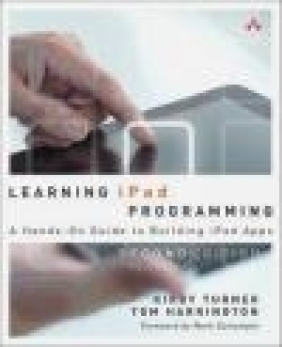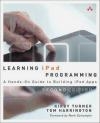Learning iPad Programming
Learning iPad Programming
- Producent: Addison Wesley Publishing Company
- Rok produkcji: 2013
- ISBN: 9780321885715
- Ilość stron: 800
- Oprawa: Miękka
Niedostępna
Opis: Learning iPad Programming
"Not many books have a single project that lives and evolves through the entire narrative. The reason not many books do this is because it is difficult to do well. Important toolkit features get shoehorned in weird places because the author didn't do enough up-front design time. This book, though, takes you from design, to a prototype, to the Real Deal. And then it goes further." -Mark Dalrymple, cofounder of CocoaHeads, the international Mac and iPhone programmer community; author of Advanced Mac OS X Programming: The Big Nerd Ranch Guide Learning iPad Programming, Second Edition, will help you master all facets of iPad programming with Apple's newest tools. Its in-depth, hands-on coverage fully addresses the entire development process, from installing the iOS SDK through coding, debugging, submitting apps for Apple's review, and deployment. Extensively updated for Apple's newest iOS features and Xcode 4.x updates, this book teaches iPad programming through a series of exercises centered on building PhotoWheel, a powerful personal photo library app. As you build PhotoWheel, you'll gain experience and real-world insights that will help you succeed with any iPad development project. Leading iOS developers Kirby Turner and Tom Harrington introduce the essentials of iOS development, focusing on features that are specific to iPad. You'll find expert coverage of key topics many iOS development books ignore, from app design to Core Data. You'll also learn to make the most of crucial iOS and Xcode features, such as Storyboarding and Automatic Reference Counting (ARC), and extend your app with web services and the latest iCloud synching techniques. Learn how to * Build a fully functional app that uses Core Data and iCloud synching * Use Storyboarding to quickly prototype a functional UI and then extend it with code * Create powerful visual effects with Core Animation and Core Image * Support AirPrint printing and AirPlay slideshows * Build collection views and custom views, and use custom segues to perform custom view transitions Download the free version of PhotoWheel from the App Store today! Import, manage, and share your photos as you learn how to build this powerful app. "This amazing, thorough book takes an interesting approach by working through the design and development of a simple, yet realistic, iPad app from start to finish. It is refreshing to see a technical book that explains how and why without inundating you with endless toy examples or throwing you into a sea of mind-numbing details. Particularly amazing is that it does this without assuming a large amount of experience at first. Yet it covers advanced topics at sufficient depth and in a logical order for all developers to get plenty of valuable information and insight. Kirby and Tom know this material and have done a great job of introducing the various frameworks and the reasoning behind how, why, and when you would use them. I highly recommend Learning iPad Programming to anyone interested in developing for this amazing platform." -Julio Barros, E-String.com "This is a great introduction to iPad programming with a well-done sample project built throughout. It's great for beginners as well as those familiar with iPhone development looking to learn the differences in developing for the larger screen." -Patrick Burleson, Owner, BitBQ LLC (http://bitbq.com) "Kirby Turner and Tom Harrington's Learning iPad Programming provides a comprehensive introduction to one of today's hottest topics. It's a great read for the aspiring iPad programmer." -Robert Clair, Author, Learning Objective-C 2.0 "Learning iPad Programming is now my go-to reference when developing apps for the iPad. This book is an absolute treasure trove of useful information and tips for developing on the iPad. While it's easy to think of the iPad as just a bigger iPhone, there are specific topics that need to be treated differently on the iPad, such as making best use of the larger display. Learning iPad Programming provides an incredible amount of depth on all areas of iPad programming and takes you from design to fully functioning application-which for me is a killer feature of the book. This should be in everyone's reference library." -Mike Daley, Author, Learning iOS Game Programming; Cofounder, 71Squared.com "A truly well-rounded book with something for every iOS developer, be they aspirant or veteran. If you are new to iOS, there is a solid foundation provided in Part I that will walk you through Objective-C, the core Apple frameworks, provisioning profiles, and making the best of Xcode. If you've been around the block but want solid insight into iPad programming, Part II has you covered: Rather than just providing canned example code, Kirby and Tom give you real code that incrementally builds and improves a real app. And if you've been working with iOS for a while, but would benefit from a walk-through of the plethora of new features that have come our way with iOS 5 and Xcode 4, dive into the chapters on Storyboards, iCloud, and Core Image. Best of all, the book is well-written and conversational, making it a joy to read. This book is stellar." -Alexis Goldstein, Coauthor, HTML5 & CSS3 for the Real World "Learning iPad Programming is one of the most comprehensive resources on the planet for those developing for Apple's iPad platform. In addition to coverage of the language, frameworks, and tools, it dives into features new in iOS 5, like Automatic Reference Counting, Storyboarding, and connecting your applications with iCloud. But where this book really shines is in the tutorials and the application you will build as you read through this book. Rather than being a toy that employs only off-the-shelf iOS user interface components from Interface Builder, the PhotoWheel app demonstrates custom view programming and view controller containment, nonstandard gesture/user input handling, and provides insight into how a complex iOS project comprised of multiple subsystems is assembled into a shipping application. In other words, Learning iPad Programming shows how to deal with the challenges you'll face in real iPad development." -Erik Price, Senior Software Engineer, Brightcove "A thoroughly crafted guide for learning and writing iOS applications, from the humble beginnings in Xcode and Interface Builder to creating a full-featured iPad application. There are many books that try to cover the gamut of knowledge required to take a reader from zero to app; Kirby and Tom have actually done it in this book. It is a fun and comprehensive guide to the world of developing apps for Apple's magical device." -Rod Strougo, Founder, Prop Group "The iPad is changing the way we think about and use technology. Learning iPad Programming is one of the most in-depth and well-executed guides to get both new and seasoned developers up to speed on Apple's exciting new platform." -Justin Williams, Crew Chief, Second GearForeword xxv Preface xxix Acknowledgments xlv About the Authors xlvii Part I: Getting Started 1 Chapter 1: Your First App 3 Creating the Hello World Project 3 Getting Text on the Screen 11 Say Hello 13 Summary 19 Chapter 2: Getting Started with Xcode 21 The IDE 21 Workspace Window 22 Preferences 29 Developer Documentation 37 Editors 38 Project Settings 40 Schemes 42 Organizer 43 Other Xcode Tools 44 Summary 45 Chapter 3: Getting Started with Interface Builder 47 Interface Builder 47 How Does IB Work? 48 Getting Hands-On Practice with IB 49 Connecting Your NIB to Your Code 61 Storyboards 70 Summary 70 Chapter 4: Getting Started with Objective-C 71 What Is Objective-C? 71 Hands-On Practice with Objective-C 72 Memory Management 93 Summary 95 Chapter 5: Getting Started with Cocoa 97 The Cocoa Stack 97 Foundation 99 UIKit 112 Common Design Patterns in Cocoa 121 Summary 123 Chapter 6: Provisioning Your iPad 125 About the iOS Provisioning Portal 125 The Provisioning Process: A Brief Overview 127 Setting Up Your Development Machine 130 Setting Up Your Device 138 Using the iOS Provisioning Portal 141 Summary 149 Chapter 7: App Design 151 Defining Your App 151 A Sample App Charter 156 UI Design Considerations 158 Mockups 164 Prototyping 171 Summary 173 Part II: Building PhotoWheel 175 Chapter 8: Creating a Master-Detail App 177 Building a Prototype App 177 A Closer Look 183 A Tour of UISplitViewController 189 Summary 195 Exercises 196 Chapter 9: Using Table Views 197 First Things First 197 A Closer Look 201 Working with a Table View 203 Summary 233 Exercises 234 Chapter 10: Using Collection and Custom Views 235 Collection Views 235 Custom Views 246 A Wheel View 248 A Carousel View 256 A Photo Wheel View Cell 263 Summary 268 Exercises 268 Chapter 11: Using Touch Gestures 269 Touch Gestures Explained 269 Custom Touch Gestures 275 Summary 283 Exercises 283 Chapter 12: Adding Photos 285 Two Approaches 285 Using the Image Picker Controller 286 Summary 299 Exercises 299 Chapter 13: Data Persistence 301 The Data Model 301 Building the Model with Core Data 302 Using Core Data in PhotoWheel 312 Adding Custom Code to Model Objects 321 Using SQLite Directly 335 Summary 336 Exercises 336 Chapter 14: Storyboarding in Xcode 337 What Is a Storyboard? 337 Storyboarding PhotoWheel 341 Summary 357 Exercises 357 Chapter 15: View Controllers and Segues 359 Implementing a View Controller 359 Container View Controllers 364 Segue 369 Customizing the Pop Transitions 381 Summary 385 Exercises 385 Chapter 16: Building the Main Screen 387 Reusing Prototype Code 388 Displaying Photo Albums 406 Managing Photo Albums 417 A Better Photo Album Thumbnail 430 Adding Photos 434 Displaying Photos 439 Summary 446 Exercises 446 Chapter 17: Creating a Photo Browser 447 Using the Scroll View 447 Launching the Photo Browser 456 Adding Chrome Effects 468 Zooming 474 Deleting a Photo 480 Summary 488 Exercise 488 Chapter 18: Supporting Device Rotation 489 How to Support Rotation 489 Customized Rotation 495 Launch Images 513 Summary 515 Exercises 516 Chapter 19: Printing with AirPrint 517 How Printing Works 517 Adding Printing to PhotoWheel 519 Summary 523 Exercises 524 Chapter 20: Sharing with Others 525 Sending Email 525 Activity View Controller 537 Summary 540 Exercises 540 Chapter 21: Web Services 541 The Basics 541 Flickr 543 One More Thing 575 What's Missing 576 Summary 577 Exercises 577 Chapter 22: Syncing with iCloud 579 Syncing Made Simple 579 iCloud Concepts 580 Device Provisioning, Revisited 582 iCloud Considerations for PhotoWheel 586 Updating PhotoWheel for iCloud 588 Syncing Photos with iCloud 592 Going Further with iCloud 600 Summary 603 Exercises 603 Chapter 23: Producing a Slideshow with AirPlay 605 External Display Options 605 App Requirements for External Displays 606 External Display API 606 Attaching an External Display 607 Adding a Slideshow to PhotoWheel 609 Managing External Displays 613 Advancing to the Next Photo 617 Adding Slideshow User Interface Controls 620 Updating the Photo Browser 622 Finishing Up 623 Summary 624 Exercises 624 Chapter 24: Visual Effects with Core Image 625 Core Image Concepts 625 Introducing CIFilter 627 Image Analysis 630 Adding Core Image Effects to PhotoWheel 633 Summary 651 Exercises 651 Chapter 25: Going Universal 653 Why Go Universal? 653 Making a Universal App 655 Pitfalls 659 Summary 661 Exercises 662 Part III: The Finishing Touches 663 Chapter 26: Debugging 665 Understand the Problem 665 Debugging Concepts 666 Debugging in Xcode 667 Debugging Example: External Display Code 675 When You Really Need NSLog 679 Profiling Code with Instruments 681 Summary 686 Chapter 27: Distributing Your App 689 Distribution Methods 689 Building for Ad Hoc Distribution 690 Building for App Store Distribution 694 The App Store Process 698 App Information for the App Store 700 App Store Assets 702 Using iTunes Connect 703 Submitting the App 705 Going Further 706 Summary 706 Chapter 28: The Final Word 707 What's Next 708 Appendix: Installing the Developer Tools 709 Membership Has Its Privileges 709 Joining the iOS Developer Program 710 Which Program Type Is Right for You? 711 What You Need to Register 712 Installing Xcode 714 Index 717
Szczegóły: Learning iPad Programming
Tytuł: Learning iPad Programming
Producent: Addison Wesley Publishing Company
ISBN: 9780321885715
Rok produkcji: 2013
Ilość stron: 800
Oprawa: Miękka
Waga: 1 kg




















